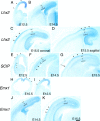Graded and areal expression patterns of regulatory genes and cadherins in embryonic neocortex independent of thalamocortical input
- PMID: 10594069
- PMCID: PMC6784968
- DOI: 10.1523/JNEUROSCI.19-24-10877.1999
Graded and areal expression patterns of regulatory genes and cadherins in embryonic neocortex independent of thalamocortical input
Abstract
The differentiation of areas of the mammalian neocortex has been hypothesized to be controlled by intrinsic genetic programs and extrinsic influences such as those mediated by thalamocortical afferents (TCAs). To address the interplay between these intrinsic and extrinsic mechanisms in the process of arealization, we have analyzed the requirement of TCAs in establishing or maintaining graded or areal patterns of gene expression in the developing mouse neocortex. We describe the differential expression of Lhx2, SCIP, and Emx1, representatives of three different classes of transcription factors, and the type II classical cadherins Cad6, Cad8, and Cad11, which are expressed in graded or areal patterns, as well as layer-specific patterns, in the cortical plate. The differential expression of Lhx2, SCIP, Emx1, and Cad8 in the cortical plate is not evident until after TCAs reach the cortex, whereas Cad6 and Cad11 show subtle graded patterns of expression before the arrival of TCAs, which later become stronger. We find that these genes exhibit normal-appearing graded or areal expression patterns in Mash-1 mutant mice that fail to develop a TCA projection. These findings show that TCAs are not required for the establishment or maintenance of the graded and areal expression patterns of these genes and strongly suggest that their regulation is intrinsic to the developing neocortex.
Figures




Similar articles
-
Distinct actions of Emx1, Emx2, and Pax6 in regulating the specification of areas in the developing neocortex.J Neurosci. 2002 Sep 1;22(17):7627-38. doi: 10.1523/JNEUROSCI.22-17-07627.2002. J Neurosci. 2002. PMID: 12196586 Free PMC article.
-
Differential expression of COUP-TFI, CHL1, and two novel genes in developing neocortex identified by differential display PCR.J Neurosci. 2000 Oct 15;20(20):7682-90. doi: 10.1523/JNEUROSCI.20-20-07682.2000. J Neurosci. 2000. PMID: 11027229 Free PMC article.
-
A lifespan analysis of intraneocortical connections and gene expression in the mouse I.Cereb Cortex. 2011 Jun;21(6):1311-30. doi: 10.1093/cercor/bhq212. Epub 2010 Nov 8. Cereb Cortex. 2011. PMID: 21060110 Free PMC article.
-
Intrinsic and extrinsic factors that shape neocortical specification.Trends Neurosci. 2001 Jul;24(7):417-23. doi: 10.1016/s0166-2236(00)01853-1. Trends Neurosci. 2001. PMID: 11410273 Review.
-
Intermediate targets in formation of topographic projections: inputs from the thalamocortical system.Trends Neurosci. 2004 Sep;27(9):533-9. doi: 10.1016/j.tins.2004.06.014. Trends Neurosci. 2004. PMID: 15331235 Review.
Cited by
-
Thalamic control of neocortical area formation in mice.J Neurosci. 2013 May 8;33(19):8442-53. doi: 10.1523/JNEUROSCI.5786-12.2013. J Neurosci. 2013. PMID: 23658181 Free PMC article.
-
Evolution of Telencephalon Anterior-Posterior Patterning through Core Endogenous Network Bifurcation.Entropy (Basel). 2024 Jul 26;26(8):631. doi: 10.3390/e26080631. Entropy (Basel). 2024. PMID: 39202101 Free PMC article.
-
Miswiring of limbic thalamocortical projections in the absence of ephrin-A5.J Neurosci. 2002 Nov 1;22(21):9352-7. doi: 10.1523/JNEUROSCI.22-21-09352.2002. J Neurosci. 2002. PMID: 12417660 Free PMC article.
-
Identity of neocortical layer 4 neurons is specified through correct positioning into the cortex.Elife. 2016 Feb 12;5:e10907. doi: 10.7554/eLife.10907. Elife. 2016. PMID: 26880563 Free PMC article.
-
A novel role for Dbx1-derived Cajal-Retzius cells in early regionalization of the cerebral cortical neuroepithelium.PLoS Biol. 2010 Jul 27;8(7):e1000440. doi: 10.1371/journal.pbio.1000440. PLoS Biol. 2010. PMID: 20668538 Free PMC article.
References
-
- Briata P, Di Blas E, Gulisano M, Mallamaci A, Iannone R, Boncinelli E, Corte G. EMX1 homeoprotein is expressed in cell nuclei of the developing cerebral cortex and in the axons of the olfactory sensory neurons. Mech Dev. 1996;57:169–180. - PubMed
-
- Caviness VS., Jr Neocortical histogenesis in normal and reeler mice: a developmental study based upon [3H]thymidine autoradiography. Brain Res. 1982;256:293–302. - PubMed
Publication types
MeSH terms
Substances
Grants and funding
LinkOut - more resources
Full Text Sources
Molecular Biology Databases
